 |
|
|
|
| Автор |
Сообщение |
sly

Зарегистрирован: 16.06.2003
Сообщения: 4503
Откуда: с далекого острова
|
 Добавлено: Вт Фев 17, 2009 10:52 pm Заголовок сообщения: статейка про резину eng Добавлено: Вт Фев 17, 2009 10:52 pm Заголовок сообщения: статейка про резину eng |
 |
|
Прикольная статейка про резину, прошу прощения что на английском, переводить времени нет, думаю кому интересно прочитают, кому нет хоть картинки посмотрят 
| тырено с pinkbike писал(а): |
I think tires are super important for both racing and riding around on your local trails, so I decided to write my first tech article on tires and tire selection. I try my best to get the most out of my tires and try to use the best tire for the conditions. I see so many posts on the local forums with people asking "What tire should I use?". And what about all those racers showing up to races with worn out tires that aren't intended for the course conditions. Hopefully what I've learned over the last couple years could be of some use to you.
I personally think there are three important factors for tires:
- 1. Tire Condition
- 2. Tire Selection
- 3. Tire Pressure
1. Tire Condition
Make sure you have tires that are in good condition when you go racing. The tire is the only thing in contact with the ground. Good new tires have sharp edges, taller knobs, and will give more grip than worn out tires. More grip means you can corner harder, brake later, and carry more speed through difficult technical sections.
Look at the comparison of the two tires below:
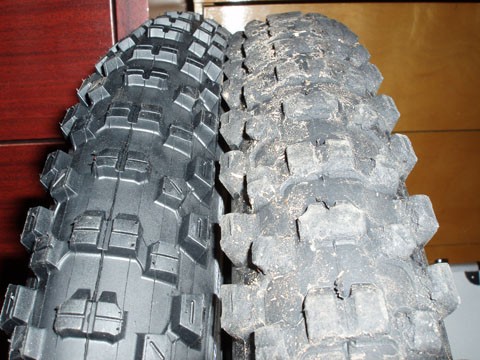
A new and worn out 2.5" Kenda Nevegal
The problem with the tire on the right is that even though it still has a significant amount of meat left in the knob the sharp edges have been rounded off due to braking and cornering. The sharp edges generate a ton of grip, and with out these edges the tire will never perform as well as it did when it was new. Having new tires on your bike will improve your times at the races.
But I can't afford a new set of tires for every race you say. I've heard that comment a thousand times. This is my trick. Decide to buy one or two sets of race tires. If you're going to buy one set get a tire that is going to perform well in all conditions. Buying 2 sets of tires is better. A set for the dry and a set for the wet. See the tire selection section below for my opinions on what tires to use in a variety of conditions. Put these good tires on your bike on Saturday morning, practice and race on these tires, then pull them off Sunday night and save them for the next race. When your race tires wear out, and are no longer good enough for racing, use them for practice tires. Do all your riding and training on old worn out tires. Yes it's a pain to constantly switch the tires on your bike, but this way you'll always have good tires come race day, and without having to spend a ton of money on new tires all the time.
Another tip. You love those 3C Maxxis Minion tires, but they're $90 each in the store, and you can never find them on a good deal. Try out some slightly cheaper tires. Kenda Tires offer all the performance of the Maxxis or Michelin tires, at a fraction of the price at $65 a tire, and last longer. You can get 3 Kenda tires for the price of 2 Maxxis or Michelin tires, which means more race tires. If you're dead set that the Maxxis or Michelin tire makes you faster on the race course, keep them as a race tire, and do your practice and training on the less expensive Kenda Tires. The money you save by buying the cheaper tires for the off season may mean you have some extra cash for another set of race tires you love for next season.
2. Tire Selection
No single tire is ideal for all conditions, this is obvious. What isn't so obvious, is which tire is best suited to the current conditions. For this reason I'm going to split this section into a couple sections based on course conditions:
- A. Hardpack Courses
- B. Loose over Hardpack Courses
- C. Wet Courses
- D. Muddy Courses
2A. Hardpack Courses
For a hard packed course you're going to want a tire that rolls well since rolling speed is likely going to help. You want the tire to have a large ramped center knob that will create a large contact area with the ground, with a ramp to reduce rolling resistance. Tall skinny knobs down the center and on the sides are going to squirm because they can't penetrate the surface, will create significant rolling resistance, and won't offer much grip. In short you want a tire with lots of contact area and with short, stable center and side knobs. This combination will give the least rolling resistance, good grip, and the most predictable handling on hardpack conditions. My personal favorite tire for these conditions is the Stick-E Kenda Nevegal, 2.5" for the front and 2.35" for the rear. I like this 2.5" / 2.35" combination because the larger front tire offers better braking and cornering grip, but the rear tire has less rolling resistance. I like the Nevegal because it has great short, ramped knobs down the center that are large and blocky, with the side knobs being similar in design. The tire is predictable, stable and rolls fast. A good choice from the Maxxis line would be the 3C Minion DHF, and a good Michelin tire is the Comp 24.

Kenda Nevegal

Maxxis Minion DHF

Michelin Comp 24
2B. Loose over Hardpack Courses
Loose over hardpack is generally any type of loose material on top of a hard packed in surface. This generally takes the form of sand, loam or gravel. These surfaces are tricky because the sections of the course that are soft and loose material is found are the sections where you need the most grip (because that's where everyone is cornering and braking). Where you don't need the grip, the course is generally hard packed. You could use one of the hard pack tires I recommended in 2A, but since they all have short large blocky knobs, they don't penetrate into that soft loose material very well, and don't provide a great amount of traction. The ideal tire is something that has a deep but large and blocky knob that is stable, yet tall enough to generate grip in that loose stuff. There is really only one tire I like for these conditions and it's the Kenda Excavator. Both the 2.5" and the 2.35" Stick-E versions are excellent. Both have the same size knobs, with the only difference being a slightly smaller casing for the 2.35" and the center knobs on the 2.35" are significantly shorter than those on the 2.5". I've run the 2.5" Excavator on the front and the 2.35" Excavator on the rear on courses where having low rolling resistance is important but need both braking and cornering grip into and through some loose corners. Dual 2.35" Excavators would likely be a good choice for even lower rolling resistance if there isn't much heavy braking, and could also be a good setup for mostly hard pack conditions. The difference between the 2.5" and 2.35" Excavator can be seen below:

Kenda Excavator 2.5"

Kenda Excavator 2.35". Notice how the knobs are the same size in terms of area, but the knobs on the 2.35" are much shorter
2C. Wet Courses
I personally love riding and racing in the wet. I like it because I love how the tire reacts differently to roots, rocks, dirt and mud ... it's much more interesting than when things are dry. For wet conditions a tire needs to be able to penetrate the wet ground and generate grip. A large blocky knob like those found on the Nevegal and Minion won't penetrate the ground well, and are going to slip around on the roots. A good wet tire needs a fairly open tread to allow mud to clear, but enough small knobs to form around objects, penetrate the ground, and provide lots of edges for braking and cornering grip. However for most BC courses a spike tire isn't the ticket because of the large amount of rock or root require a knob that has good support. My default wet weather tire is the 2.4" Stick-E Kenda Telonix tire on the front and rear. The Telonix has a series of ramped, thin, but wide and sharp bars down the center for excellent braking grip, but with reasonable rolling resistance. These sharp bars are separated by a pair of side by side spikes that offer good lateral stability. The side knobs are a series of H-shaped knobs separated by a single spike. These side knobs offer good penetration but also have lots of edges that generate good cornering grip. My pick from Maxxis for wet conditions would be the 2.5" Super Tacky High Roller, and my pick from Michelin would be the 2.5" Comp 16. You can see obvious similarities between these three tires, which is why they all excel in wet conditions.

Kenda 2.4" Telonix

Maxxis High Roller

Michelin Comp 16
2D. Muddy Courses
I have personally never used a mud spike tire before, so I can't offer up any opinions on which of the spike tires out there is the best. Click here to check out an article that Si Paton wrote for Pinkbike on Mud tires though[смотри след пост]. For severe mud conditions the wet weather tires I recommended in section 2C are likely going to clog up with mud, and won't have tall enough knobs to generate good levels of grip in deep mud. There are 4 really good mud tires on the market. The Kenda King of Traction, the Maxxis Wet Scream, the Maxxis Swamp Thing and the Michelin Mud 3. There has been a recent trend of cutting down Wet Screams and using them on wet or drying courses instead of using a Telonix or High Roller as well as on muddy courses. I can't say I've ever tried this, but it seems to be working for the World Cup guys, cutting tires is a science, and one I'll hopefully write more about in a later tech article. The Swamp Thing is not as aggressive as the other three tires and fits between the High Roller and the Wet Scream, this is evident when you look at the pictures below. Unfortunately I couldn't find a good picture of the King of Traction as it was only just release in the fall of 2008. As a result I don't have a set yet, nor could I find any pictures online.

Maxxis Wet Scream

Maxxis Swamp Thing

Michelin Mud 3
3. Tire Pressure
Tire pressure is very important, and something you should play around with. Every good rider and racer should have a repeatable tire pressure gauge. This is important for being able to achieve repeatable tire pressures. For the record I'm 195 lb, so all tire pressures are for a rider of my weight. If you weigh less you'll likely run lower tire pressures, and if you weight more you'll likely run higher tire pressures.
As a quick diversion I almost always use a regular 0.8 mm wall thickness cross country tube in the front, and a good medium weight 1.2 mm wall thickness free ride tube in the rear. I find this gives a good compromise between flat resistance and weight. For a smooth course I might use cross country tubes front and rear, and for a very aggressive course where I'm running low tire pressures for grip I might use a free ride tube in the front and rear.
For wet conditions you're generally going to want to run lower tire pressures to help the tire conform over everything on the trail, in order to help generate some much needed grip. In wet conditions rolling resistance likely isn't your first concern, so go ahead and lower those tire pressures. Don't change your tire pressures just before the race. Make sure you've worked out the ideal tire pressure long before practice is up in order to ensure you won't flat during the race. I personally use around 25 psig in the front and about 27 psig in the rear for wet courses. If I'm struggling for grip and can get away with the lower pressures I may lower than even further.
For dry conditions I generally use an intermediate tire pressure of 28 psig in the front and 32 psig in the rear. This offers a good compromise between rolling resistance, grip, and stability. In the dry you can corner harder, and you don't want the tire to be rolling around on top of the rim.
For hard pack conditions run high tire pressures. I generally use 32 psig in the front and 35 psig in the rear, sometimes even more at places like The Ranch in Kamloops. There is no need for low tire pressures in hard pack conditions. Running low tire pressures isn't going to give any more grip and you'll only gain stability in the corners and lower the rolling resistance with higher tire pressures. Since edges aren't a help in hard pack conditions anyway having more edges in contact with the ground isn't going to increase the amount of grip, so keep those tires nice and hard.
4. The End
That wraps up my first tech article on tires and tire pressures. I'll be posting up another tech article soon. Let me know if there is something in particular you'd like me to write about. If you have any questions, comments, if I've missed something, or you feel I'm just plain wrong, please leave a comment below. |
|
|
| Вернуться к началу |
|
sly

Зарегистрирован: 16.06.2003
Сообщения: 4503
Откуда: с далекого острова
|
 Добавлено: Вт Фев 17, 2009 11:01 pm Заголовок сообщения: Добавлено: Вт Фев 17, 2009 11:01 pm Заголовок сообщения: |
 |
|
Для любителей помесить каку подробней про муды
| аттуда же писал(а): |
Mud, mud, glorious mud, there's nothing more like it for cooling the blood! Today’s lesson is on Mud Tyres so best be paying attention as there might be a question or two later.
First off lets dispel all those idiots on the forum that say, “I ride Minions in the mud and they work really well”. Read on to learn what you really need to win races!
When the going gets tough we are here to talk about Mud Tyres which are also known as Spike Tyres. These funnily enough have rubber molded spikes which have two great qualities! First off they “Dig” into the ground for superb traction in corners and straights.
Now the clever bit! Unlike your standard High Roller / Minion Tyre with rubber shaped blocks that hold onto the mud and clog up, thus turning your rough knobbly tyre into a slippery slick looking affair. Spikes whilst rotating “Throw” the mud off as the mud has not much to grip onto between those spaced out spikes. By the time it’s got back around to contacting the ground it’s clear. There is one catch as always, you need to keep that mud tyre rolling, the faster it spins the clearer it gets, the more grip you have and the quicker you are!
Before we get to your choices of tyres, life isn’t that simple, we need to chat about compounds, the rubber itself.
These are measured using the Durometer rating, think of a hard skateboard wheel, they are usually 90-99a durometer. DH race tyres should be soft and grippy, only negative is they will wear out quickly. A brand new rear SuperTacky at Fort William goes in the skip Sunday night.
If you ride a Slow Reezay there it would be in that bin Saturday night! Slow Reezay is a compound with a durometer rating of 40a. This is a super soft compound with slow rebound properties, you can bend the spikes back and you will visibly see that they return slowly to their original position. This compound allows for traction and speed to be maintained on highly technical terrain. Ideally run on the front tyre! Awesome grip, slowest rolling resistance on the straights and wears out fast. JUST NOTE THEY ARE NO LONGER AVAILABLE IN THE UK!
Super Tacky is a compound with a durometer rating of 42a. This means that it is a soft compound that allows the rider to have superb surface traction and is for race use only.
This is the most common durometer run on race circuits across the World and is the “Racers” choice. It will roll faster than a Slow Reezay, last longer but will have less grip.
MaxxPro 60a compound used to come with the orange band around it, that band has now been dropped. Maxxis has exclusive use of the Exxpro polymer, created by Exxon that is blended with the MaxxPro elastomer, which allows soft tyres to have a long tread life without compromising the increase in traction and lower rolling resistance that softer compounds provide.
This bits from the manual as I didn't take Chemistry:
All MaxxPro tyres benefit from 100% perfectly dispersed carbon black. The carbon black molecules are ground smaller and thus more closely arranged than carbon black found in other manufacturer’s compounds. The result is a smoother tyre surface that wears longer than traditional compounds. Maxxis’ perfect dispersion of carbon black also minimizes cut growth in instances where the tread becomes torn or cut. The tyre also rolls faster as a result of the rubber recovering quicker.
If you are on a budget these will last for ages, will wear well but grip is sacrificed. That said how about running one on the back at Fort Bill to help you stay up at speed? Also note these are top sellers for those out to France, Sweden or Whistler, again on the back they will last the full week and you won’t have to give some smelly French Frog 8.2 million Euros for a new tyre!
Nearly there:
Maxxis do two types of sidewall for their tyres, single ply or dual ply (sometimes called two ply). Single ply is very thin on the sidewall and great for XC, 4x or even trail bossing when pumped up to over 40psi. For DownHill they are as useful as a chocolate fireguard as the tyre rolls over as the sidewall as the foundation is thin and floppy as Tyler and Jordan's wrists. They will also increase your chance of pinch puncturing and kill you in a tight turn. They should carry a Public Health Warning like f*gs on them if you ever, ever intend to use them for DH.
For downhill you must have the Dual Ply, 60 *tpi (threads per inch) casings, vulcanized with butyl rubber and reinforced sidewalls provide more stability at high speeds and in the corners. You can then run lower air pressures for better grip without the risk of pinch flatting and serious injury after being spat over in a corner.
*TPI stands for Threads Per Inch. It defines the number of threads contained in one inch of the tire casing. The lower the number of TPI, the larger the gauge cords in the casing. Thus, the more durable the tyre becomes. The higher the TPI, the more lightweight the tyre becomes and the more supple the ride of the tyre.
What else?
Tubeless tyres allow you to run lower air pressure without having to worry about pinch flatting a tube. This allows for maximum traction because you have more surface area contact with the ground. You just need tubeless rims and a lot of patience unless your into that Stan’s No Tubes DIY kit. We will review one of those later.
Very nearly there, what width?
Realistically you are looking at a few options, narrow or wide? Now that all depends on the course conditions doesn’t it? General rule of thumb is - if it is really muddy, like when your trainer nearly gets sucked off when walking the course then the narrower the better. A narrower tyre will cut into the mud much better. The fatter the tyre the more chance it will float on top of the mud and have less grip. Think of that BMW 3 series spinning whilst an old Polo or Citroen 2CV rockets out of the muddy field.
Let's also think about your weight/size. Anyone under 10stone should be running a 2.35” or narrower tyre. Those over that weight as a general guide should be running a 2.5” and be going on a diet unless of course you are “Big Boned”.
You may also think about running a wider tyre upfront for extra grip when turning and run a narrower one on the rear to cut in and grip along the straights when you are pedaling your fat tits off whilst blowing out of your ass.
Now here are your tried and tested options:
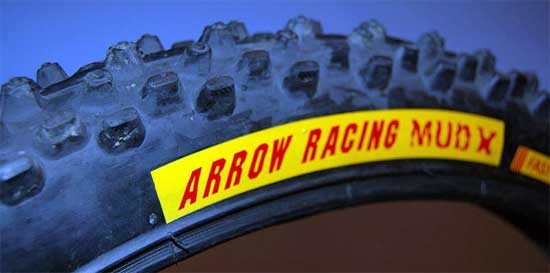
24inch riders?
Arrow Racing Mud-X 24x 2.3” which I guess will be a God send for all those Specialized Big Hitters out there? 9mm high spikes dig deep into the mud so you won't get slipping off anywhere, not the softest compound, why worry though, you will be running it on the back anyway. These will be mega on really muddy grassy courses like Moelfre and Rugog as those spikes will stick into anything. Guessing they would work a treat on snow as well!
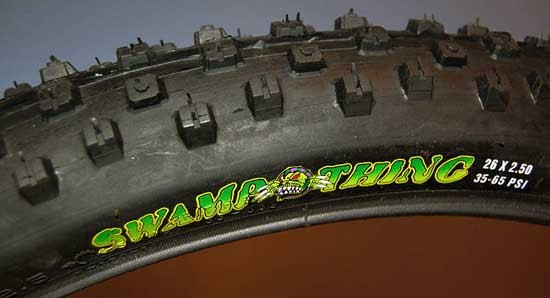
Swampthings
Maxxis also do the Swampthing, rare as rocking horse pooh!
24x 2.5” 42a
24x 2.5” 62a
Now for the real boys:
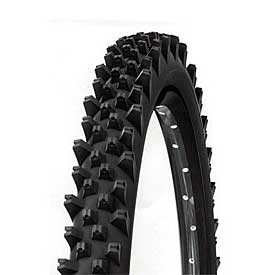
Michelin Mud 3's
Michelin Mud 3 UST (Tubeless Compatible but can be used with tubes!) 26x 2.2” Don’t be put off by that narrow 2.2” width, these come up in between a Maxxis 2.35 to 2.5” tyre. These were the tyre of choice at Rugog or Moelfre on a sodden wet, muddy peaty and grassy course. They dug in so well, just note there were no roots on that course. What you often find is some top boys who have to ride Michelin start cutting down those spikes slightly on wet courses littered with roots and rocks. You see those tall rubber spikes aren’t the most stable on rocks or roots as they flex around a little and this is the only mud tyre Michelin do.
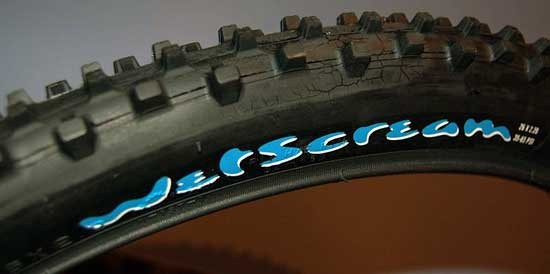
Maxxis WetScream
26x 2.2” 42a
26x 2.5” 40a
26x 2.5” 42a
26x 2.5” 42a UST (Tubeless Compatible)
Very similar to the Michelin Mud 3s above, these definitely come out when the going gets tough and sloppy. They can be run in any direction so run them one week with the big yellow Maxxis logo on one side then swap the week after if you want them to wear evenly and can be bothered!

Maxxis SwampThings
26x 2.5” 42a
26x 2.5” 60a
26x 2.5” 42a UST (Tubeless Compatible)
The SwampDonkeys as Will Longden calls them are commonly known on the circuit as the best all round mud tyre. Grip wise they are in between the WetScream and the HighRoller. When the mud is sticking to your frame and you then it is time to put on these little numbers. Just remember to run the yellow Maxxis logo on the drive side as they are directional. A close look at those knobs and you will notice they are ramped one side, this helps the tyre roll over obstacles. The backside is straight up so when braking giving the maximum vertical stopping ledge to help you stop on a dime.
Hope that makes sense? If not and you're trackside at a DH race in the U.K then pop on over and I'll hold your hand as we walk through tyre choices.
Stay Unclipped
Si Paton
www.Descent-Gear.com
Troy Lee Lids Instock! |
|
|
| Вернуться к началу |
|
ural_v
Зарегистрирован: 26.01.2007
Сообщения: 681
Откуда: Уфа
|
 Добавлено: Чт Фев 19, 2009 11:44 am Заголовок сообщения: Добавлено: Чт Фев 19, 2009 11:44 am Заголовок сообщения: |
 |
|
полностью ищо не прочитал, но вроде интересно.
Чот показалось Максис вс Кенда, кенду хвалят, х.з.
з.ы. за ссылко зачет! |
|
| Вернуться к началу |
|
Малыш

Зарегистрирован: 17.05.2005
Сообщения: 1212
Откуда: УФА
|
 Добавлено: Чт Фев 19, 2009 4:39 pm Заголовок сообщения: Добавлено: Чт Фев 19, 2009 4:39 pm Заголовок сообщения: |
 |
|
Честно говоря, ИМХО, напоминает рекламную акцию кенды, либо матерьял проплаченный обоими производителями (ну и плюс мичлен).
Думаю не секрет для всех, кто юзал кенду, что в мокрую и сырую погоду - резина она вообще никакующая, только для дрифта годиться. Ездить конечно можно, но дополнительный экстрим как то не вставляет...
На счет максиса - резинки данного производителя радовали меня ни один год и не одну зиму, но как говориться - качество познаеться в сравнении, и вот сравнивая, я уже нашел покрышки поинтереснее - тиога. Сейчас использую Блу Драгон, держит просто прекрасно, даже с твердым компаундом. Единственный из минусов - вне леса и земли стираеться на раз-два-три. Впрочем углы протекторов на хайроллере стоя переди тоже достаточно быстро округлились в городе.
В ближайшем будущем хочу поюзать швальбе - очень хваленая резина, не знаю как покажет себя в деле. Но судя по цене - работать должна хорошо. |
|
| Вернуться к началу |
|
ural_v
Зарегистрирован: 26.01.2007
Сообщения: 681
Откуда: Уфа
|
 Добавлено: Чт Фев 19, 2009 6:08 pm Заголовок сообщения: Добавлено: Чт Фев 19, 2009 6:08 pm Заголовок сообщения: |
 |
|
| Малыш писал(а): |
Думаю не секрет для всех, кто юзал кенду, что в мокрую и сырую погоду - резина она вообще никакующая, только для дрифта годиться. Ездить конечно можно, но дополнительный экстрим как то не вставляет...
|
а ты про какую кенду говоришь, а? Слегка не корректно как-то, все-таки не одна покрышка уних. И в каких условиях каталась?
Невегал стик е на банчиге вроде неплохо держит. |
|
| Вернуться к началу |
|
МаНъЯг=)
Зарегистрирован: 03.08.2008
Сообщения: 164
Откуда: уфа
|
 Добавлено: Чт Фев 19, 2009 10:21 pm Заголовок сообщения: Добавлено: Чт Фев 19, 2009 10:21 pm Заголовок сообщения: |
 |
|
По моему мнению если сравнивать Kenda Nevegal stick E и Maxxis High Roller , то для меня лутше кенда(испытывал на банчике). Мне кажеться что у кенды накат быстрее и в крутых поваротах держит как бы лутше.. Но я за миньон !  |
|
| Вернуться к началу |
|
Малыш

Зарегистрирован: 17.05.2005
Сообщения: 1212
Откуда: УФА
|
 Добавлено: Пт Фев 20, 2009 12:28 am Заголовок сообщения: Добавлено: Пт Фев 20, 2009 12:28 am Заголовок сообщения: |
 |
|
| ural_v писал(а): |
А ты про какую кенду говоришь, а? Слегка не корректно как-то, все-таки не одна покрышка уних. И в каких условиях каталась?
Невегал стик е на банчиге вроде неплохо держит. |
Я катал долгое время на Навегале, на нескольких разных ее вариациях, очень неудовлетворен сцеплением на влажной земле и снегу. Возможно у меня был жесткий компаунд, но резина мне очень не понравилась.
| МаНъЯг=) писал(а): |
По моему мнению если сравнивать Kenda Nevegal stick E и Maxxis High Roller , то для меня лутше кенда(испытывал на банчике). Мне кажеться что у кенды накат быстрее и в крутых поваротах держит как бы лутше.. Но я за миньон !  |
Твой многолетний опыт, показывают, что я, ниразу не катавший ни на том ни на другом, ошибаюсь  
Хайроллер - не плохая резина, Миньен - так же не плох. Зимой понравилось использования Болотной штуковины от Максиса - редкий шип не собирает снег, но резина трескаеться на морозе, да и накат у нее никакой...
Предлагаю сделать таблицу баллов для резины, с пояснениями.
И так, резина которую использовал я:
1. Kenda Nevega - 5/10 не держит на мокром
2. Maxxis High Roller - 7.5/10 хороша, но 1ный компаунд очень легко рвется об камни.
3. Maxxis Swamp Thing - 6/10 не накатистая
3. Tioga Blue Dragon - 9/10 все супер, только стираеться слишком быстро (ЛУЧШАЯ ЦЕНА)
4. WTB moto Raptor Comp - 3/10 отвратительно, даже на сухом грунте
5. DMR moto digger - 6/10 хороший накат, отличная боковая устойчивость на вилли, в горах тоже не плохо, но можно было бы и лучше
6. Continental Diesel - 5/10 в сухую погоду замечательна, но даже на мокром асфальте становиться травмоопасна
7. Tioga White Tiger DH - 6/10 хороша резина, но опять же слишком стирается и весит до черта (полтора кг на покрышку 2.5!)
Вообще,ИМХО, идельным размером для фрирайда и дх любых покрышек считаю 2.35-2.4, большие и широкие покрышки никак себя не оправдывают, кроме как лишей массой. Более тонкие - это уже кросс кантри.
Опишите резину которую использовали вы. |
|
| Вернуться к началу |
|
ural_v
Зарегистрирован: 26.01.2007
Сообщения: 681
Откуда: Уфа
|
 Добавлено: Пт Фев 20, 2009 11:26 am Заголовок сообщения: Добавлено: Пт Фев 20, 2009 11:26 am Заголовок сообщения: |
 |
|
| Малыш писал(а): |
Я катал долгое время на Навегале, на нескольких разных ее вариациях, очень неудовлетворен сцеплением на влажной земле и снегу. Возможно у меня был жесткий компаунд, но резина мне очень не понравилась.
Опишите резину которую использовали вы. |
Ну ты и крендель. 
Тебя не смущает, что кенда невегал предназначена для сухих, возможно каменистых поверхностей? |
|
| Вернуться к началу |
|
МаНъЯг=)
Зарегистрирован: 03.08.2008
Сообщения: 164
Откуда: уфа
|
 Добавлено: Пт Фев 20, 2009 1:41 pm Заголовок сообщения: Добавлено: Пт Фев 20, 2009 1:41 pm Заголовок сообщения: |
 |
|

Последний раз редактировалось: МаНъЯг=) (Чт Фев 26, 2009 7:02 pm), всего редактировалось 2 раз(а) |
|
| Вернуться к началу |
|
МаНъЯг=)
Зарегистрирован: 03.08.2008
Сообщения: 164
Откуда: уфа
|
 Добавлено: Пт Фев 20, 2009 1:43 pm Заголовок сообщения: Добавлено: Пт Фев 20, 2009 1:43 pm Заголовок сообщения: |
 |
|

Последний раз редактировалось: МаНъЯг=) (Чт Фев 26, 2009 7:00 pm), всего редактировалось 2 раз(а) |
|
| Вернуться к началу |
|
|
|
|
|